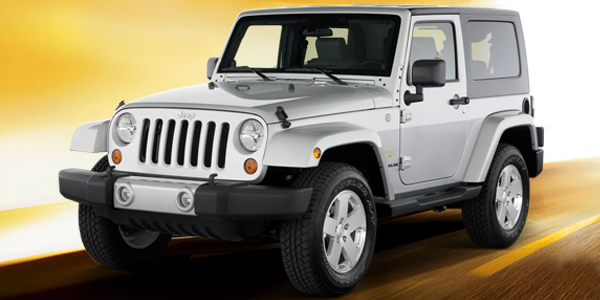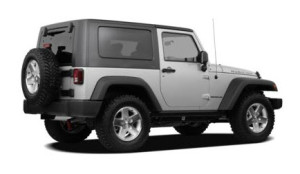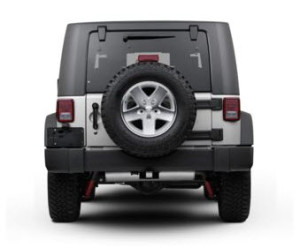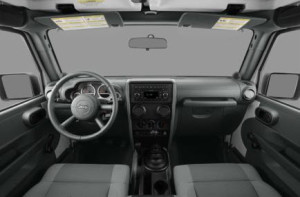
Jeeps have always been a unique vehicle to drive and the 2010 Jeep Wrangler Sahara brings the Jeep concept to a whole new level. Originally created for military use during WWII, many of its traditional stylings can still be seen in the current design. With standard and optional features that give it all the features of other SUVs in its class plus the usual beefier offroading specifications.
 Containing the typical Jeep Shift-on-the-Fly 4×4 system, you can shift from 4WD High, 4WD Low or 2WD while on the move. The powerful 3.8L V6 (outputting 202HP @ 5,200 RPM & 237ft-lb torque at 4,000 RPM) ensures you are never lacking power for towing, off-roading or overtaking. The 6-speed manual transmission comes standard, with an optional upgrade to the 5-speed automatic. The extra 6th gear on the manual transmission is great for highway driving, keeping the RPMs and fuel consumption low while cruising.
Containing the typical Jeep Shift-on-the-Fly 4×4 system, you can shift from 4WD High, 4WD Low or 2WD while on the move. The powerful 3.8L V6 (outputting 202HP @ 5,200 RPM & 237ft-lb torque at 4,000 RPM) ensures you are never lacking power for towing, off-roading or overtaking. The 6-speed manual transmission comes standard, with an optional upgrade to the 5-speed automatic. The extra 6th gear on the manual transmission is great for highway driving, keeping the RPMs and fuel consumption low while cruising.
The Wrangler Sahara is the top of the line model, priced slightly higher than the Wrangler & Wrangler Sport. With this extra investment, you’ll get beefier axles, full metal doors with power windows, fog lamps, remote keyless entry, security alarm, tow hooks, air conditioning, side steps, Infinity stereo system, larger 18” tires, colour matched fender flares and a leather wrapped steering wheel. Additional options include a colour matched hard top and leather seating. Keep in mind that all models come in a 2 door or 4 door (called the Unlimited) version.
 Driving the 2010 Jeep Wrangler Sahara is a hugely different experience from the older model Jeeps (2006 and older). Older Jeeps used to have a loud engine, a bumpy ride, wind noise and a bare bones rickety driving feel. Driving the 2010 Jeep is a whole other experience – a smooth ride, quiet inside the cabin and a solid driving feel. One great bonus is the Hill-Assist feature which locks the vehicle from rolling backwards on a hill for 2 seconds, giving you time to shift into 1st gear without the need for the parking brake. While the Jeep is not great on gas (I was averaging 13.5 L/100km combined city/hwy over 1,000kms of driving), using the manual transmission and shifting below 2,000 RPM, I was able to average 9.8 L/100km.
Driving the 2010 Jeep Wrangler Sahara is a hugely different experience from the older model Jeeps (2006 and older). Older Jeeps used to have a loud engine, a bumpy ride, wind noise and a bare bones rickety driving feel. Driving the 2010 Jeep is a whole other experience – a smooth ride, quiet inside the cabin and a solid driving feel. One great bonus is the Hill-Assist feature which locks the vehicle from rolling backwards on a hill for 2 seconds, giving you time to shift into 1st gear without the need for the parking brake. While the Jeep is not great on gas (I was averaging 13.5 L/100km combined city/hwy over 1,000kms of driving), using the manual transmission and shifting below 2,000 RPM, I was able to average 9.8 L/100km.
 What makes Jeeps unique are its simple design and ability to convert into an entirely different vehicle. It’s convertible with either a soft top or a 3 piece hard top (allowing you to easily remove the front passenger sections and optionally the whole roof). When not driving on the city streets, you can also remove the doors and fold down the windshield! What I have always loved about Jeeps are the huge tires, which add a whole different look and capability to the vehicle. The closest comparables would be the Toyota FJ Cruiser or the Land Rover, however with the Jeep’s price tag being nearly half of their price, I would hardly say it’s “comparable”.
What makes Jeeps unique are its simple design and ability to convert into an entirely different vehicle. It’s convertible with either a soft top or a 3 piece hard top (allowing you to easily remove the front passenger sections and optionally the whole roof). When not driving on the city streets, you can also remove the doors and fold down the windshield! What I have always loved about Jeeps are the huge tires, which add a whole different look and capability to the vehicle. The closest comparables would be the Toyota FJ Cruiser or the Land Rover, however with the Jeep’s price tag being nearly half of their price, I would hardly say it’s “comparable”.
It’s no wonder that Jeeps have come a long way since their creation, they are after all the oldest SUV/offroad vehicle brand.




